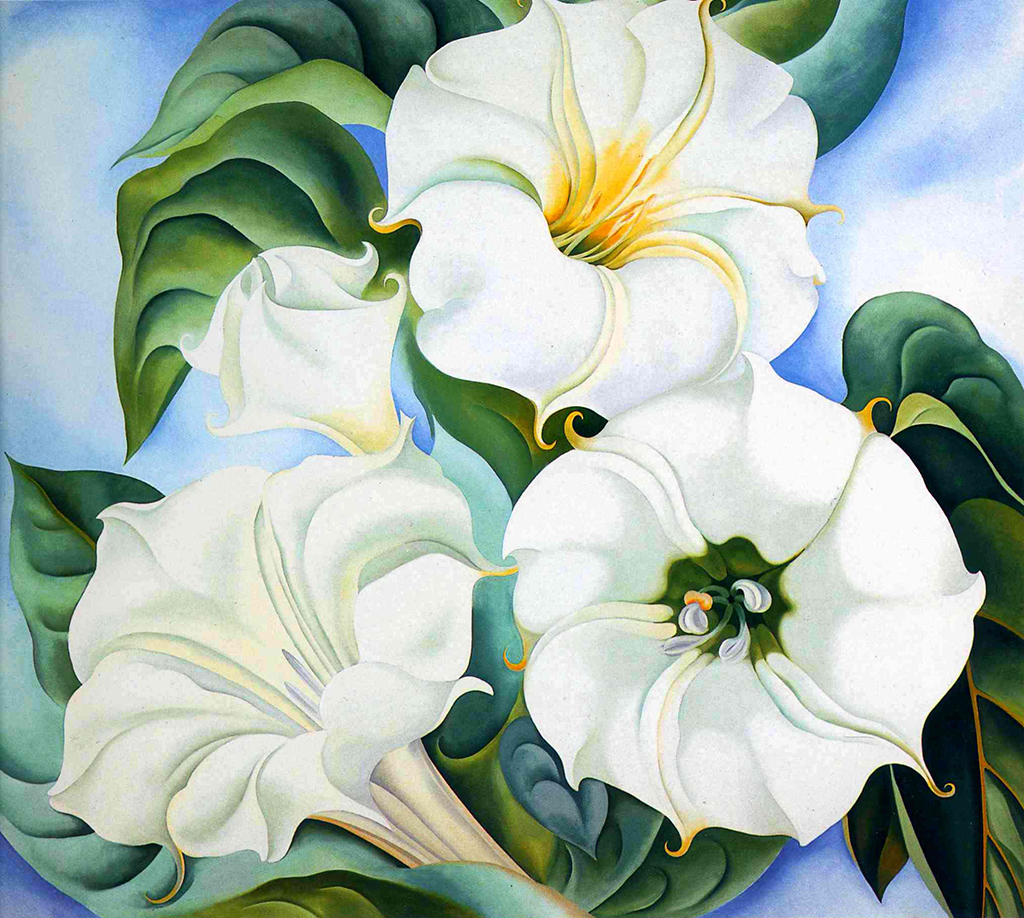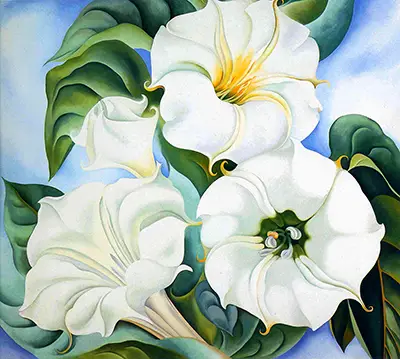Jimson Weed is a painting by the late American artist Georgia O'Keeffe. Elizabeth Arden commissioned the work to go in the Gymnasium Moderne of her Fifth Avenue Salon, New York City. It was completed in 1936 and is now located in the Indianapolis Museum of Art in Indianapolis. Arden paid $10,000 dollars for this artwork, which was the largest floral painting the artist ever completed. It is an oil on linen painting measuring 180 by 212 centimetres. It is almost the most expensive painting ever sold by a female artist at auction, selling for over $44m. The painting consists of four flowers in an energetic design that replicates the pinwheel shaped flowers. A version with just one flower head was produced earlier in 1932 and was titled Jimson Weed / White Flower No 1.
Georgia O'Keeffe would take flowers from her garden from time to time and use for these still life depictions. Whilst doing this was nothing new, what made her work unique was the way in which she zoomed in onto just one or two single flower heads, allowing their individual detail to show through in ways not really seen before. She also had a modernist style which was different to other flower artists of previous centuries. It was these two ingredients that helped to make paintings such as Jimson Weed just quite so memorable, and put this genre firmly into the trademark style of her oeuvre, even though many other types of content were also employed at different stages. The artist was also a keen gardener and this would help provide a link between the content and her art, as well as influencing the choices of plants and flowers that she would have chosen for her garden.
As with the earlier version, we find here flower heads superimposed on top of some of the plant's leaves, with a blue and white background set behind. In this example she chooses to use more heads together, but they are still large enough to again appreciate the detail. There are touches of orange and yellow for the internal elements of each flower, which works beautifully up against the white petals and the darker green leaves behind. She allows us to see these plants in ways that we have never done so before, where normally would glance from afar and not take the time to study the inner workings. We can see the same again in a number of other still life flower paintings, such as Oriental Poppies, Petunias and Black Iris. The full array of this genre feature a wide selection of bright colours, taking in reds, whites, purples, yellows and many more. She would always be on the look out for something new to cultivate within her garden and then later place on canvas.
This plant is also known by a number of other names, such as devil's snare, thorn apple, or its original title of Datura stramonium. It is a part of the nightshade family and also the Datura genus. It is actually considered an invasive weed, but with the benefit of beautiful white flowers that so appealed to the artist. They originate from Central America but would have been able to survive within the climate in which O'Keeffe was living during the 1930s. Besides its clear beauty, it has also been used in a number of medicines, underlining its versatility and intrinsic value in a variety of ways. It can however be toxic when used inappropriately, so it probably best enjoyed from a visual sense rather than ingesting, which is not advisable without professional guidance.
The painting can be found in the Indianapolis Museum of Art and ranks as one of the highest profile pieces within their collection. Their permanent selection of work is varied, going back way beyond just the 20th century and some of their other highlights include Fine Wind, Clear Morning by Katsushika Hokusai, Hotel Lobby by Edward Hopper, Boat Builders by Winslow Homer and also a good number of JMW Turner watercolours. In total, there are thousands of items to enjoy here, many of which are rotated every few months in order to keep the display fresh and also allow the public to see as much of their collection as possible. Whilst not achieving the fame as the likes of MoMA, this is certainly a major art institution which serves American art particularly well.

